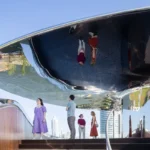The role of branding in real estate and architectural projects, Best realtor advice, Property selling advice
The Role of Branding in Real Estate and Architectural Projects
28 November 2024
Branding plays a pivotal role in shaping industries, and its influence on real estate and architectural projects is both profound and transformative. A carefully crafted brand strategy helps developers, architects, and marketers establish an identity that resonates with target audiences, builds trust, and elevates projects in a competitive marketplace. Below, we explore the multifaceted importance of branding in real estate and architecture, exploring how it drives success, fosters engagement, and ensures long-term value.
Understanding Branding in the Context of Real Estate and Architecture
Branding in real estate and architecture is far more than a logo or slogan; it’s a strategic process of creating an identity that reflects a project’s ethos, vision, and unique value proposition. A well-defined brand communicates the purpose of a development, whether residential, commercial, or mixed-use, to potential buyers, tenants, and investors.
Architectural branding often intersects with visual storytelling, as the design language and architectural style become an extension of the brand. For example, modern skyscrapers with sleek, glass facades might symbolize innovation and progress, while eco-friendly designs speak to sustainability and environmental consciousness. These elements work together to create a cohesive narrative that appeals to the target demographic.
Moreover, branding is essential for differentiation. In a crowded market, especially in urban areas where new developments frequently emerge, a strong brand sets a project apart. Whether it’s through innovative design, luxury amenities, or cultural relevance, the brand identity becomes the project’s unique selling point.
Building Trust and Emotional Connections
In real estate, a brand is not just about the physical structure but also about the emotional connections it fosters. Buyers and tenants are more likely to invest in projects that align with their aspirations and lifestyle goals. Emotional branding helps developers create this resonance by crafting messages and visuals that evoke specific feelings.
A critical aspect of this is the concept of storytelling. Real estate projects often have a backstory, whether it’s a revitalized neighborhood, a heritage site repurposed for modern use, or a state-of-the-art development. Effective branding uses these narratives to build trust and emotional engagement. Potential customers are not just buying property; they’re buying into the vision and story that the brand represents.
Additionally, trust is built through consistency. From digital campaigns to on-site experiences, a cohesive and reliable brand presence reassures customers of the project’s quality and the developer’s credibility. This consistency becomes especially crucial in markets where trust deficits can deter potential investments.
The Intersection of Branding and Marketing in Real Estate
Marketing plays a crucial role in amplifying a real estate brand’s reach, and the two functions are deeply intertwined. Branding lays the groundwork for marketing efforts, offering a clear message and identity for promotional strategies. Together, they ensure that the project reaches the right audience with the right narrative.
Digital marketing, in particular, has transformed the way real estate brands are built. Social media campaigns, SEO-driven content, and virtual tours all contribute to establishing a memorable brand presence. Platforms like Instagram and LinkedIn allow brands to showcase their architectural designs, highlight amenities, and connect with audiences on a personal level.
Collaborations with creative agencies have also revolutionized branding in the real estate sector. For instance, Designity’s real estate marketing services
provide developers with tailored strategies to enhance brand visibility and appeal. By leveraging Creative-as-a-Service (CaaS) models such as the ones offered by Designity, developers can access high-quality design and marketing solutions that align with their brand vision.
Architectural Identity as a Branding Tool
Architectural identity is a cornerstone of branding in real estate projects. The visual design of a building, including its structure, materials, and spatial layout, becomes a physical embodiment of the brand. Developers increasingly collaborate with architects to ensure the building itself communicates the brand message.
Consider luxury developments that emphasize exclusivity. These projects often feature designs with meticulous attention to detail, opulent interiors, and bespoke amenities. The architectural identity of such projects mirrors the brand promise of sophistication and premium living. Similarly, eco-conscious developments integrate green roofs, solar panels, and energy-efficient designs to reflect a commitment to sustainability.
The success of this approach lies in seamless integration. The architectural style must not only be visually striking but also functionally aligned with the brand’s goals. This alignment ensures that the design speaks to the needs and desires of the intended audience.
Branding for Long-Term Value
The influence of branding extends beyond the launch of a project. A strong brand identity contributes to long-term value appreciation, making it a critical asset for developers and investors. Real estate brands that emphasize quality, innovation, and customer satisfaction often see higher retention rates and positive market reception over time.
For buyers and tenants, branded developments offer a sense of assurance. They associate the brand with reliability, which enhances their willingness to invest. This trust often leads to word-of-mouth recommendations and repeat customers, further solidifying the brand’s reputation.
Moreover, branding impacts resale value. Properties in well-branded developments tend to maintain or appreciate their value due to the prestige and trust associated with the brand. This makes branding a strategic advantage for developers aiming for sustained success in competitive markets.
Challenges in Real Estate Branding
While branding offers immense benefits, it also comes with challenges that developers must navigate. One of the primary hurdles is aligning the brand identity with diverse stakeholder expectations. Real estate projects involve investors, architects, local authorities, and end-users, each with unique priorities and perspectives.
Another challenge lies in maintaining authenticity. Modern consumers are quick to spot insincerity, making it imperative for brands to deliver on their promises. This requires meticulous planning and execution, ensuring that every aspect of the project—from marketing to construction—aligns with the brand message.
Lastly, adapting to changing market trends is a constant challenge. A brand that successfully appeals to today’s audience might need to evolve to stay relevant in the future. Flexibility and foresight are crucial for overcoming this hurdle without compromising the core identity of the brand.
The Future of Branding in Real Estate and Architecture
As technology and consumer preferences evolve, so too does the role of branding in real estate and architecture. Virtual reality, augmented reality, and AI-driven design tools are shaping how projects are presented and marketed. These technologies allow developers to create immersive brand experiences that engage audiences in new and exciting ways.
Sustainability and social responsibility are also becoming integral to branding strategies. Buyers increasingly prioritize developments that align with ethical values, making green initiatives and community-focused designs essential components of the brand narrative. This shift not only enhances market appeal but also aligns with global efforts to create a more sustainable future.
Finally, branding in real estate and architectural projects is no longer a secondary consideration but a fundamental pillar of success. By investing in thoughtful, authentic, and innovative branding strategies, developers can create projects that resonate deeply with their audiences, driving both immediate and long-term value.
Comments on guide to The Role of Branding in Real Estate and Architectural Projects article are welcome.
Building Articles
Residential Architecture
Real Estate Agents
Real Estate Agent Posts
What is a realtor vs. Real estate agent

6 major pitfalls to avoid by using a real estate agent
5 signs that you hired the wrong real estate agent

Comments / photos for the The Role of Branding in Real Estate and Architectural Projects page welcome






